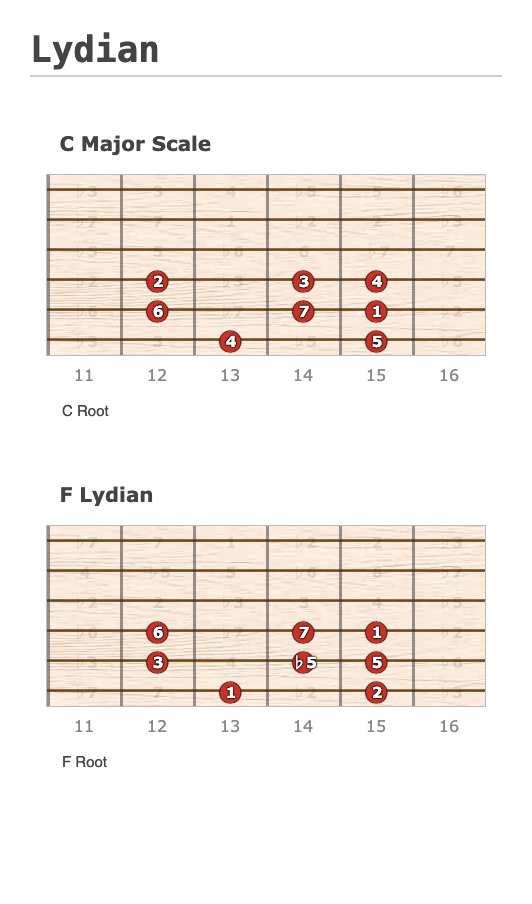Lydian
Introduction
The Lydian mode is a mode which is derived from the major scale with a raised fourth (4#) scale degree, which gives it a distinct sound.
Structure of the Lydian Mode
The Lydian mode is the fourth mode of the major scale. Its formula is:
1, 2, 3, #4, 5, 6, 7
Each mode has its own unique formula of intervals (whole and half steps). For any given root note, we can apply the formula to create each of the seven modes for that root.
The Lydian mode has the following interval formula:
- Intervals:
- Root
- Major 2nd
- Major 3rd
- Augmented 4th (#4)
- Perfect 5th
- Major 6th
- Major 7th
In other words, the interval formula is W – W – W – H – W – W – H.
Example:
Notes of the C Lydian Scale: C – D – E – F# – G – A – B – C
Lydian in Action
Iconic Examples:
- “Flying in a Blue Dream” by Joe Satriani
- This instrumental track is often cited as a classic example of the Lydian mode in rock music, showcasing its bright and expansive sound.
- “Dreams” by Fleetwood Mac
- From their iconic album “Rumours,” this song subtly incorporates the Lydian mode to create an ethereal atmosphere, enhancing its emotional depth.
- “Freewill” by Rush
- This progressive rock song features sections that utilize the Lydian mode, contributing to its complex and dynamic structure.
Constructing Lydian Mode
The fourth note of the major scale as root note is Lydian.
Chord Quality
Diatonic Triads in Lydian Mode
| Degree | Chord Type | Example C Lydian (C - D - E - F# - G - A - B) | Notes in the Example C Lydian |
|---|---|---|---|
| I | Major | C | C - E - G |
| II | Major | D | D - F# - A |
| III | Minor | Em | E - G - B |
| IV | Diminished | F#dim | F# - A - C |
| V | Major | G | G - B - D |
| VI | Minor | Am | A - C - E |
| VII | Minor | Bm | B - D - F# |
Diatonic 7th Chords in Lydian Mode
| Degree | Chord Type | Example (C Lydian) | Notes |
|---|---|---|---|
| I | Major 7 (#11) | Cmaj7#11 | C - E - G - B |
| II | Dominant 7 | D7 | D - F# - A - C |
| III | Minor 7 | Em7 | E - G - B - D |
| IV | Minor 7♭5 (Half-Diminished) | F#m7♭5 | F# - A - C - E |
| V | Major 7 | Gmaj7 | G - B - D - F# |
| VI | Minor 7 | Am7 | A - C - E - G |
| VII | Minor 7 | Bm7 | B - D - F# - A |
Common Lydian Chord Progressions
- I-II Progression: C - D
- I-II-III Progression: C - D - Em
- I-V with Suspended: C - Csus2 - G
- I-IV-V (Altered): C - F#dim - G
- vi-IV-I-V: Am - F#dim - C - G
When using 7th chords in the Lydian mode, the chord progressions can be similar to those with triads, but with added complexity from the 7ths.
